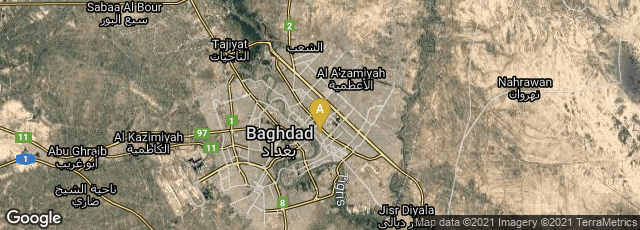

A: Baghdad, Al Saadoon Park, Baghdad Governorate, Iraq
On January 17, 1991 at 2:30 AM Baghdad time CNN newscaster Peter Arnett broadcast live television coverage of the bombing of Baghdad from room 906 of the Al-Rasheed Hotel. This was the first live television coverage of war. During this period Baghdad was subjected to the most severe bombing in military history.
CNN was the only news outlet with the ability to communicate from inside Iraq during the initial hours of the Coalition bombing campaign, with live reports by Bernard Shaw, John Holliman, and Charles Jaco, as well as Arnett. This story was a watershed event for CNN that catapulted the channel past the "Big Three" American networks for the first time in its history, largely due to this unprecedented, historical scoop.
"Because it was unable to immediately broadcast live pictures from Baghdad, CNN's coverage of the initial hours of the Gulf War had the dramatic feel of a radio broadcast – and was compared to legendary CBS news anchor Edward R. Murrow's gripping live radio reports of the German bombing of London during World War II. Despite the lack of live pictures, CNN's coverage was carried by television stations and networks around the world, resulting in CNN being watched by over a billion viewers worldwide – a feat that led to the subsequent creation of CNN International" (Wikipedia article on CNN, accessed 10-21-2014).
"We had a bird's-eye view of the whole event from the ninth floor of the Al-Rashid Hotel in the middle of Baghdad, which was where the media was staying. The bombing began at 2:30 a.m. Baghdad time on an absolute clear starry night. So we could see all the bombs exploding across the city. And it was incredibly dramatic. We had a big advantage in that our communications link to the CNN headquarters in Atlanta held up throughout this early phase of the bombing. So the three of us, Bernard Shaw, John Holliman and I, soon to be known as the Boys of Baghdad, were able to continuously report on what we were seeing. Another factor in these opening hours of the war was that we were not subject to any censorship since the Iraqi government had clearly not prepared for the bombing as far as the media was concerned. So we openly reported on buildings destroyed, the morale of the capital, the whole atmosphere of a city under severe bombing attack without interference, and we did that for the first 17 hours of the air attacks. They were the most significant attacks of the whole war. The most frightening moment was during the first hour of the bombing when the very high-powered American explosives destroyed office towers just a few blocks away from our hotel. The impact of the explosion and the heat swept through the open windows of our hotel room. Incidents like this prompted Bernard Shaw to comment on the air: "It feels like the center of hell." It was nerve-wracking to remain in the room but what motivated us to continue was the opportunity to talk to a worldwide audience about what we could see.... The bombing of Baghdad and the ground war that followed were the first time in media history, not only when both sides of a war were covered fully, but a time when much of the coverage was live. The incredible spectacle of the Gulf War persuaded CNN and other television organizations to cover successive events in the same way. So we had the O.J. Simpson trial. We had Princess Diana's death. We had wall-to-wall coverage of the recent presidential recount in Florida. What we see is what some prominent observers say is a cultural phenomenon of a "mediathon" approach to news and information. This is what the Gulf War brought to the U.S. and to the world" (Peter Arnett, A Look Back).
"The Gulf War was the first to be live from both sides -- a unique moment in communications history. We not only had the American coalition side from press briefings and on-the-scene reports in the Gulf itself, that were themselves dramatic from all the CNN correspondents located there, but we also had it from the enemy side -- the enemy capital in Baghdad. For the two-month duration of the war we were able to make regular reports to an international audience, and it made it all very exciting for everyone"--Peter Arnett. (http://www.cnn.com/COMMUNITY/transcripts/2001/01/16/arnett/, accessed 07-31-2014).